High-Conductivity MXene Film-Based Millimeter Wave Antenna for 5G Applications
Abstract
1. Introduction
2. Materials and Methods
2.1. Preparation of High-Conductivity MXene Film
2.2. Antenna Fabrication
2.3. Measurement of Array Antenna
2.4. Characterization
3. Results and Discussion
3.1. Characterization of Materials
3.2. MXene Linear Array Antenna
3.3. MXene High Gain Planar Array Antenna
4. Conclusions
Author Contributions
Funding
Institutional Review Board Statement
Informed Consent Statement
Data Availability Statement
Conflicts of Interest
References
- Jia, Q.; Xu, H.; Xiong, M.F.; Zhang, B.; Duan, J. Omnidirectional Solid Angle Beam-Switching Flexible Array Antenna in Millimeter Wave for 5G Micro Base Station Applications. IEEE Access 2019, 7, 157027–157036. [Google Scholar] [CrossRef]
- Uwaechia, A.N.; Mahyuddin, N.M. A Comprehensive Survey on Millimeter Wave Communications for Fifth-Generation Wireless Networks: Feasibility and Challenges. IEEE Access 2020, 8, 62367–62414. [Google Scholar] [CrossRef]
- Jijo, B.T.; Zeebaree, S.R.M.; Zebari, R.R.; Sadeeq, M.A.M.; Sallow, A.B.; Mohsin, S.; Ageed, Z.S. A Comprehensive Survey of 5G mm-Wave Technology Design Challenges. Asian J. Res. Comput. Sci. 2021, 8, 1–20. [Google Scholar] [CrossRef]
- Hong, W.; Jiang, Z.H.; Yu, C.; Zhou, J.; Chen, P.; Yu, Z.; Zhang, H.; Yang, B.; Pang, X.; Jiang, M.; et al. Multibeam Antenna Technologies for 5G Wireless Communications. IEEE Trans. Antenn. Propag. 2017, 65, 6231–6249. [Google Scholar] [CrossRef]
- Semkin, V.; Ferrero, F.; Bisognin, A.; Ala-Laurinaho, J.; Luxey, C.; Devillers, F.; Räisänen, A.V. Beam switching conformal antenna array for mm-wave communications. IEEE Antenn. Wirel. Propag. Lett. 2015, 15, 28–31. [Google Scholar] [CrossRef]
- Ohlen, P.; Skubic, B.; Rostami, A.; Fiorani, M.; Monti, P.; Ghebretensae, Z.; Martensson, J.; Wang, K.; Wosinska, L. Data Plane and Control Architectures for 5G Transport Networks. J. Light. Technol. 2016, 34, 1501–1508. [Google Scholar] [CrossRef]
- Ur-Rehman, M.; Abbasi, Q.H.; Rahman, A.; Khan, I.; Chattha, H.T.; Matin, M.A. Millimetre-Wave Antennas and Systems for the Future 5G. Int. J. Antenn. Propag. 2017, 2017, 6135601. [Google Scholar] [CrossRef]
- Mao, C.; Khalily, M.; Xiao, P.; Brown, T.W.C.; Gao, S. Planar Sub-Millimeter-Wave Array Antenna with Enhanced Gain and Reduced Sidelobes for 5G Broadcast Applications. IEEE Trans. Antenn. Propag. 2019, 67, 160–168. [Google Scholar] [CrossRef]
- Jilani, S.F.; Munoz, M.O.; Abbasi, Q.H.; Alomainy, A. Millimeter-Wave Liquid Crystal Polymer Based Conformal Antenna Array for 5G Applications. IEEE Antenn. Wirel. Propag. Lett. 2019, 18, 84–88. [Google Scholar] [CrossRef]
- Jiang, S.; Song, R.; Hu, Z.; Xin, Y.; Huang, G.L.; He, D. Millimeter wave phased array antenna based on highly conductive graphene-assembled film for 5G applications. Carbon 2022, 196, 493–498. [Google Scholar] [CrossRef]
- Song, R.; Wang, Z.; Zu, H.; Chen, Q.; Mao, B.; Wu, Z.P.; He, D. Wideband and low sidelobe graphene antenna array for 5G applications. Sci. Bull. 2021, 66, 103–106. [Google Scholar] [CrossRef]
- Song, R.; Mao, B.; Wang, Z.; Hui, Y.; Zhang, Z.; Fang, R.; Zhang, J.; Wu, Y.; Ge, Q.; Novoselov, K.S.; et al. Comparison of copper and graphene-assembled films in 5G wireless communication and THz electromagnetic-interference shielding. Proc. Natl. Acad. Sci. USA 2023, 120, e2085160176. [Google Scholar] [CrossRef]
- Rutherglen, C.; Jain, D.; Burke, P. Nanotube electronics for radiofrequency applications. Nat. Nanotechnol. 2009, 4, 811–819. [Google Scholar] [CrossRef] [PubMed]
- Zhang, H.B.; Zheng, W.G.; Yan, Q.; Jiang, Z.G.; Yu, Z.Z. The effect of surface chemistry of graphene on rheological and electrical properties of polymethylmethacrylate composites. Carbon 2012, 50, 5117–5125. [Google Scholar] [CrossRef]
- Shen, B.; Zhai, W.T.; Zheng, W.G. Ultrathin Flexible Graphene Film: An Excellent Thermal Conducting Material with Efficient EMI Shielding. Adv. Funct. Mater. 2014, 24, 4542–4548. [Google Scholar] [CrossRef]
- Zhang, J.Z.; Kong, N.; Uzun, S.; Levitt, A.; Seyedin, S.; Lynch, P.A.; Qin, S.; Han, M.K.; Yang, W.R.; Liu, J.Q.; et al. Scalable Manufacturing of Free-Standing, Strong Ti3C2Tx MXene Films with Outstanding Conductivity. Adv. Mater. 2020, 32, 2001093. [Google Scholar] [CrossRef] [PubMed]
- Jiang, J.; Bai, S.; Zou, J.; Liu, S.; Hsu, J.; Li, N.; Zhu, G.; Zhuang, Z.; Kang, Q.; Zhang, Y. Improving stability of MXenes. Nano Res. 2022, 15, 6551–6567. [Google Scholar] [CrossRef]
- VahidMohammadi, A.; Rosen, J.; Gogotsi, Y. The world of two-dimensional carbides and nitrides (MXenes). Science 2021, 372, eabf1581. [Google Scholar] [CrossRef]
- Naguib, M.; Kurtoglu, M.; Presser, V.; Lu, J.; Niu, J.J.; Heon, M.; Hultman, L.; Gogotsi, Y.; Barsoum, M.W. Two-Dimensional Nanocrystals Produced by Exfoliation of Ti3AlC2. Adv. Mater. 2011, 23, 4248–4253. [Google Scholar] [CrossRef]
- Zhang, H.; Wang, L.; Chen, Q.; Li, P.; Zhou, A.; Cao, X.; Hu, Q. Preparation, mechanical and anti-friction performance of MXene/polymer composites. Mater. Des. 2016, 92, 682–689. [Google Scholar] [CrossRef]
- Han, M.K.; Shuck, C.E.; Rakhmanov, R.; Parchment, D.; Anasori, B.; Koo, C.M.; Friedman, G.; Gogotsi, Y. Beyond Ti3C2Tx: MXenes for Electromagnetic Interference Shielding. ACS Nano 2020, 14, 5008–5016. [Google Scholar] [CrossRef]
- Sarycheva, A.; Polemi, A.; Liu, Y.L.; Dandekar, K.; Anasori, B.; Gogotsi, Y. 2D titanium carbide (MXene) for wireless communication. Sci. Adv. 2018, 4, eaau0920. [Google Scholar] [CrossRef] [PubMed]
- Li, Y.; Tian, X.; Gao, S.P.; Jing, L.; Li, K.; Yang, H.; Fu, F.; Lee, J.Y.; Guo, Y.X.; Ho, J.S.; et al. Reversible Crumpling of 2D Titanium Carbide (MXene) Nanocoatings for Stretchable Electromagnetic Shielding and Wearable Wireless Communication. Adv. Funct. Mater. 2019, 30, 1907451. [Google Scholar] [CrossRef]
- Han, M.; Liu, Y.; Rakhmanov, R.; Israel, C.; Tajin, M.A.S.; Friedman, G.; Volman, V.; Hoorfar, A.; Dandekar, K.R.; Gogotsi, Y. Solution-Processed Ti3C2Tx MXene Antennas for Radio-Frequency Communication. Adv. Mater. 2021, 33, 2003225. [Google Scholar] [CrossRef] [PubMed]
- Zhao, W.; Ni, H.; Ding, C.; Liu, L.; Fu, Q.; Lin, F.; Tian, F.; Yang, P.; Liu, S.; He, W.; et al. 2D Titanium carbide printed flexible ultrawideband monopole antenna for wireless communications. Nat. Commun. 2023, 14, 278. [Google Scholar] [CrossRef]
- Shao, Y.; Wei, L.; Wu, X.; Jiang, C.; Yao, Y.; Peng, B.; Chen, H.; Huangfu, J.; Ying, Y.; Zhang, C.J.; et al. Room-temperature high-precision printing of flexible wireless electronics based on MXene inks. Nat. Commun. 2022, 13, 3223. [Google Scholar] [CrossRef]
- Si, Y.; Jin, H.; Zhang, Q.; Xu, D.; Xu, R.; Ding, A.; Liu, D. Roll-to-roll processable MXene-rGO-PVA composite films with enhanced mechanical properties and environmental stability for electromagnetic interference shielding. Ceram. Int. 2022, 48, 24898–24905. [Google Scholar] [CrossRef]
- Fang, X.-Y.; Yu, X.-X.; Zheng, H.-M.; Jin, H.-B.; Wang, L.; Cao, M.-S. Temperature- and thickness-dependent electrical conductivity of few-layer graphene and graphene nanosheets. Phys. Lett. A 2015, 379, 2245–2251. [Google Scholar] [CrossRef]
- Song, R.; Zhao, X.; Wang, Z.; Fu, H.; Han, K.; Qian, W.; Wang, S.; Shen, J.; Mao, B.; He, D. Sandwiched Graphene Clad Laminate: A Binder-Free Flexible Printed Circuit Board for 5G Antenna Application. Adv. Eng. Mater. 2020, 22, 2000451. [Google Scholar] [CrossRef]
- Song, R.; Huang, G.L.; Liu, C.; Zhang, N.; Zhang, J.; Liu, C.; He, D. High-conductive graphene film based antenna array for 5G mobile communications. Int. J. RF Microw. Comput. Aided Eng. 2019, 29, e21692. [Google Scholar] [CrossRef]
- Barbiere, D. A method for calculating the current distribution of Tschebyscheff arrays. Proc. IRE 1952, 40, 78–82. [Google Scholar] [CrossRef]
- Guo, Y.Q.; Pan, Y.M.; Zheng, S.Y. Design of Series-Fed, Single-Layer, and Wideband Millimeter-Wave Microstrip Arrays. IEEE Trans. Antenn. Propag. 2020, 68, 7017–7026. [Google Scholar] [CrossRef]
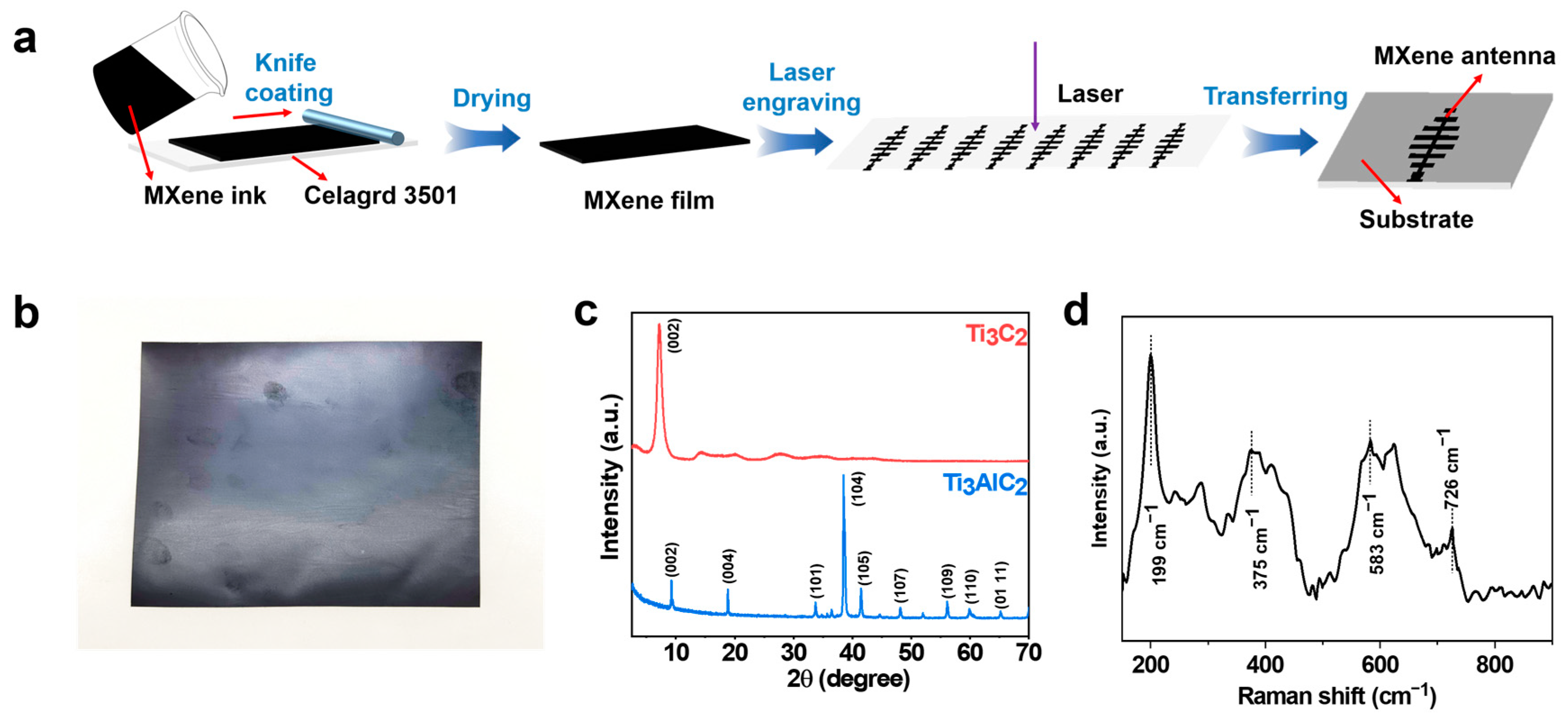
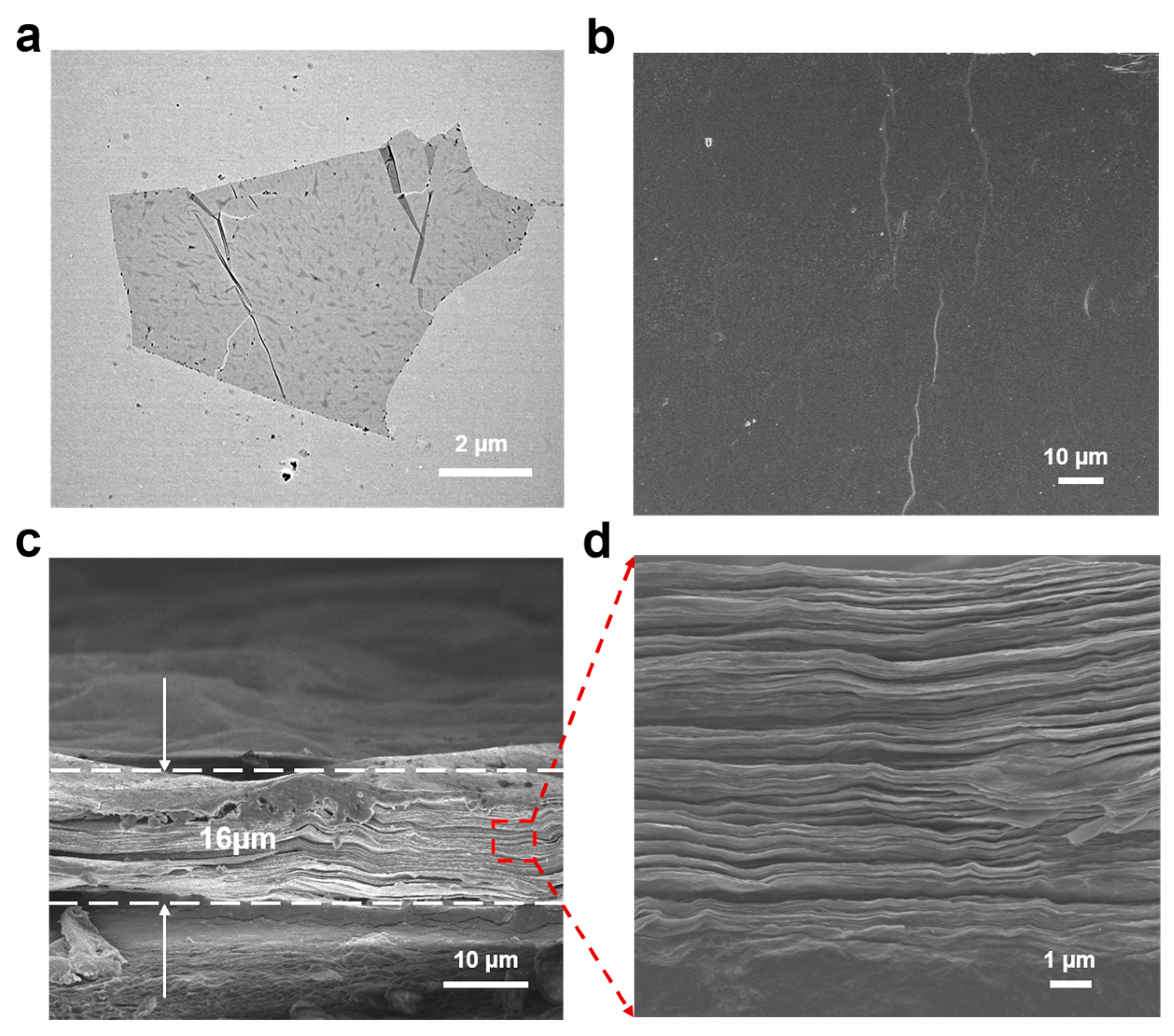
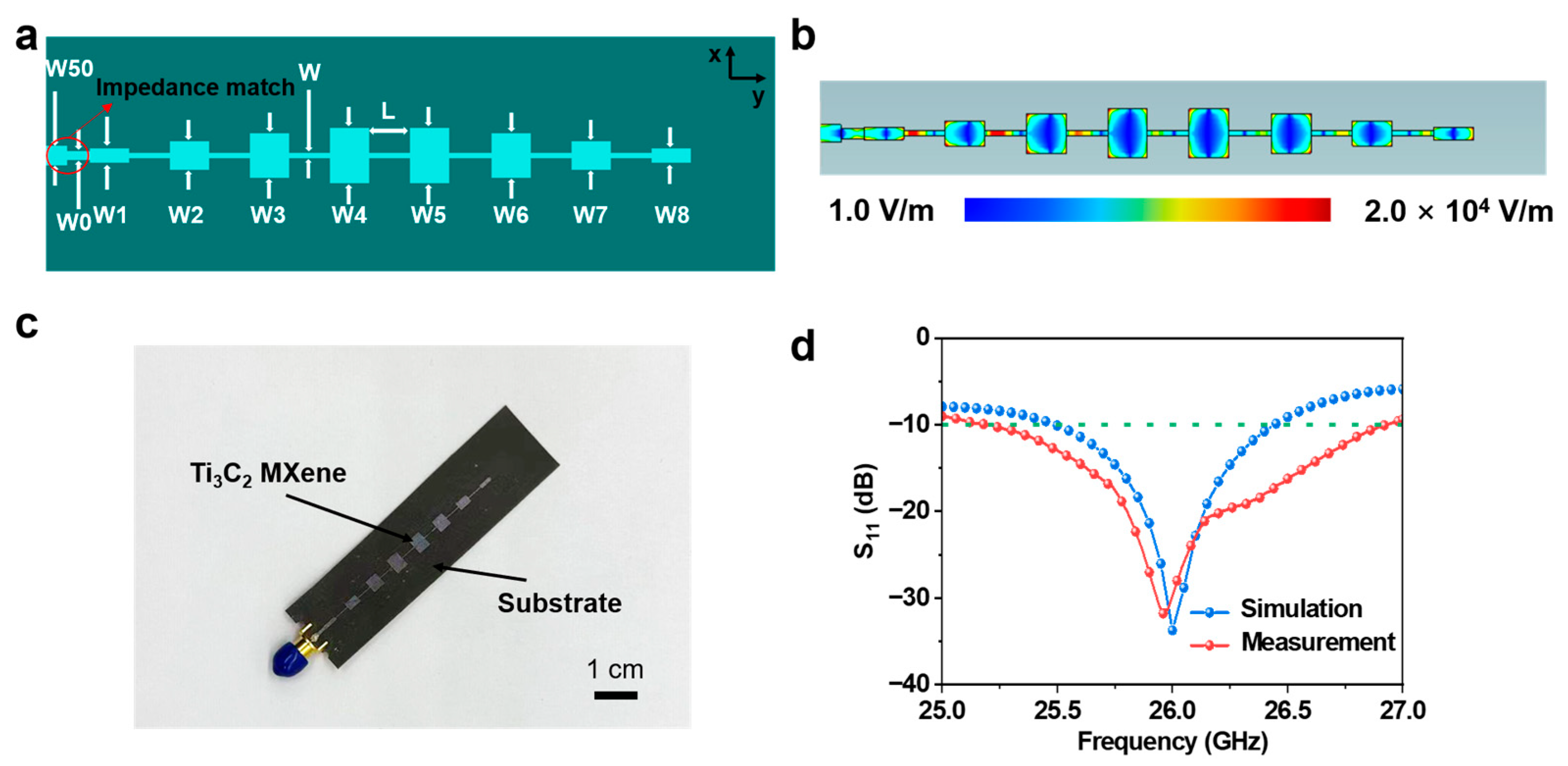

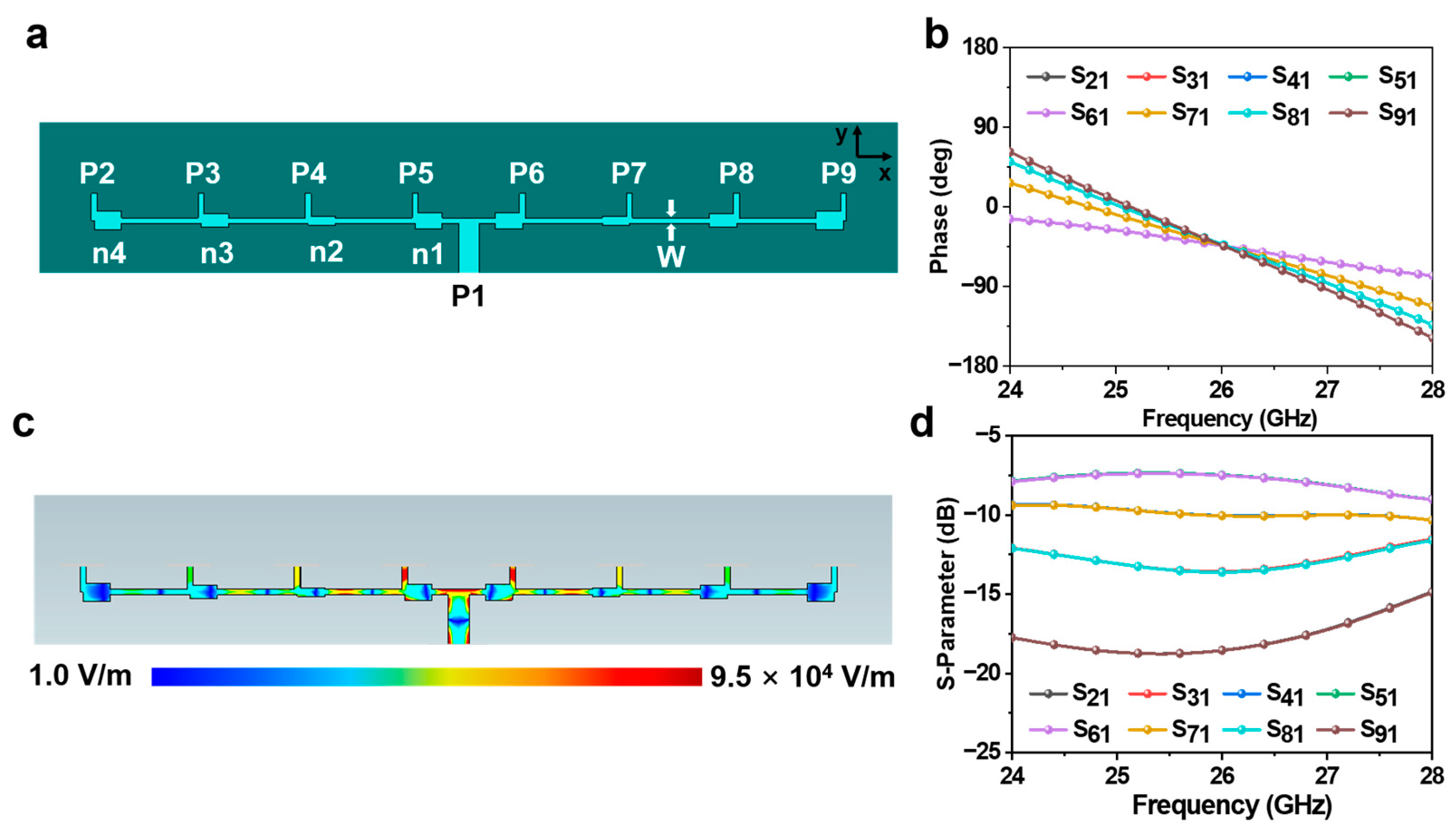

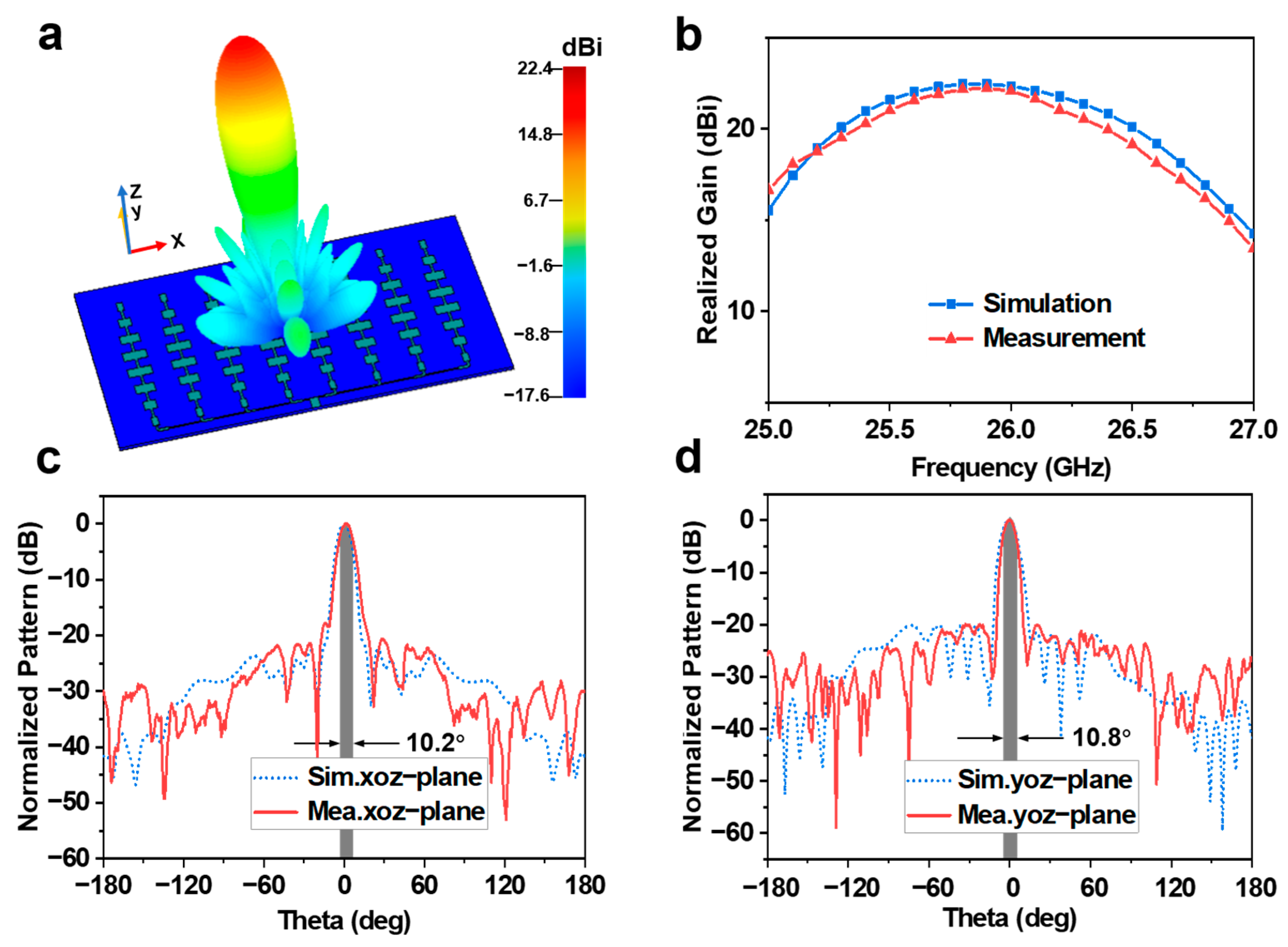
| Parameter | L | W | W1 | W2 | W3 | W4 | W5 | W6 |
| Value (mm) | 3.9 | 0.46 | 1.21 | 2.39 | 3.74 | 4.6 | 4.6 | 3.74 |
| Parameter | W7 | W8 | W0 | W50 | n1 | n2 | n3 | n4 |
| Value (mm) | 2.39 | 1.21 | 1 | 1.61 | 1 | 0.67 | 0.97 | 1.16 |
Disclaimer/Publisher’s Note: The statements, opinions and data contained in all publications are solely those of the individual author(s) and contributor(s) and not of MDPI and/or the editor(s). MDPI and/or the editor(s) disclaim responsibility for any injury to people or property resulting from any ideas, methods, instructions or products referred to in the content. |
© 2023 by the authors. Licensee MDPI, Basel, Switzerland. This article is an open access article distributed under the terms and conditions of the Creative Commons Attribution (CC BY) license (https://creativecommons.org/licenses/by/4.0/).
Share and Cite
Guo, J.; Si, Y.; Song, R.; Zu, H.; Xin, Y.; Ye, D.; Xu, M.; Li, B.-W.; He, D. High-Conductivity MXene Film-Based Millimeter Wave Antenna for 5G Applications. Crystals 2023, 13, 1136. https://doi.org/10.3390/cryst13071136
Guo J, Si Y, Song R, Zu H, Xin Y, Ye D, Xu M, Li B-W, He D. High-Conductivity MXene Film-Based Millimeter Wave Antenna for 5G Applications. Crystals. 2023; 13(7):1136. https://doi.org/10.3390/cryst13071136
Chicago/Turabian StyleGuo, Jiannan, Yunfa Si, Rongguo Song, Haoran Zu, Yitong Xin, Dong Ye, Ming Xu, Bao-Wen Li, and Daping He. 2023. "High-Conductivity MXene Film-Based Millimeter Wave Antenna for 5G Applications" Crystals 13, no. 7: 1136. https://doi.org/10.3390/cryst13071136
APA StyleGuo, J., Si, Y., Song, R., Zu, H., Xin, Y., Ye, D., Xu, M., Li, B.-W., & He, D. (2023). High-Conductivity MXene Film-Based Millimeter Wave Antenna for 5G Applications. Crystals, 13(7), 1136. https://doi.org/10.3390/cryst13071136








